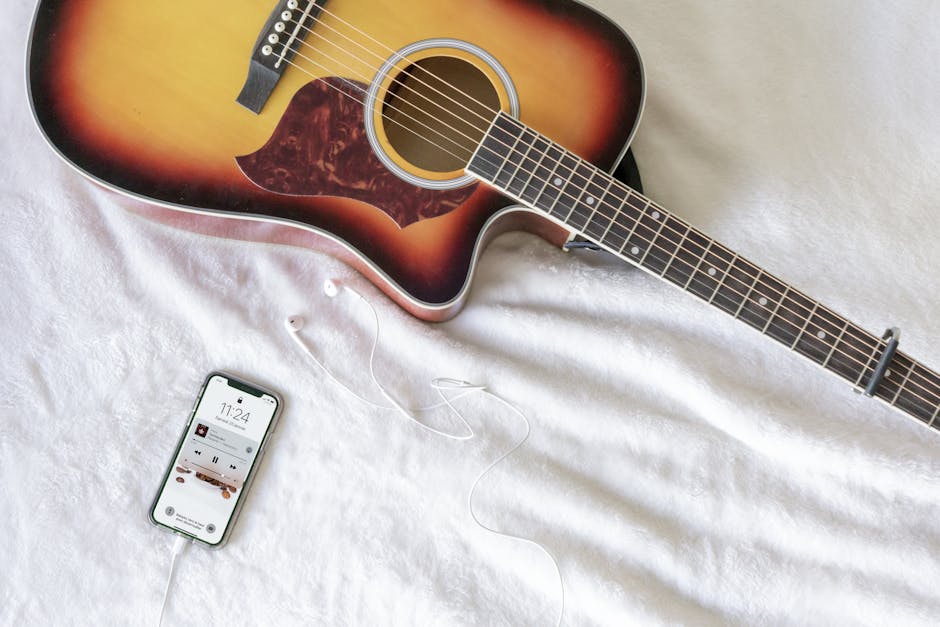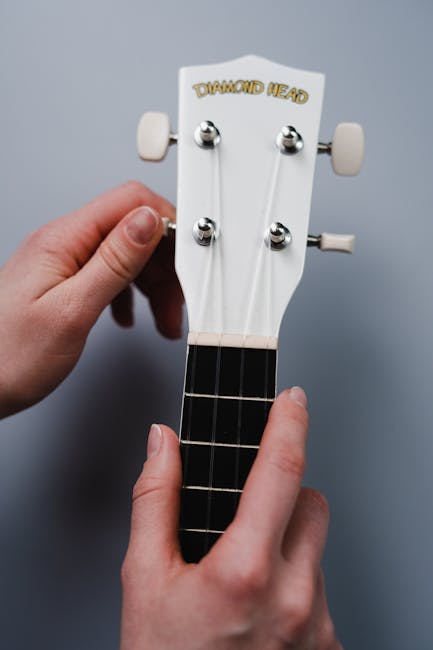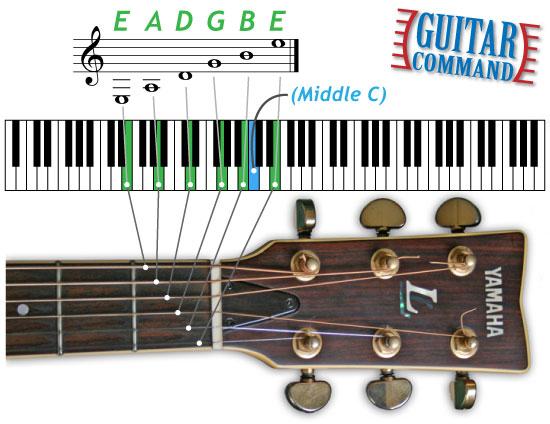So, you’ve got your acoustic guitar in hand, ready to serenade the masses with your musical prowess. But before you start strumming away, there’s one crucial step you can’t skip: tuning. That’s right, folks, we’re diving into the art of mastering precision in acoustic guitar tuning. Get ready to banish those off-key notes and unleash your inner guitar god (or goddess) with these simple steps. Just remember, even the most talented musicians were once just a G-string away from greatness. Let’s tune in and rock on!
Contents
- 1 Understanding the Basics of Acoustic Guitar Tuning
- 2 Identifying the Right Tools for Accurate Tuning
- 3 Standard Tuning: The Foundation of Guitar Music
- 4 Alternate Tunings: Expanding Your Musical Vocabulary
- 5 Achieving Harmony: Fine-Tuning Each String
- 6 Tuning Stability: Ensuring Your Guitar Stays in Tune
- 7 Advanced Techniques: Using Harmonics for Precise Tuning
- 8 FAQs
- 9 Rock on, Tuning Maestro!
Understanding the Basics of Acoustic Guitar Tuning
So you finally decided to learn how to tune your acoustic guitar, huh? Well, buckle up because we’re about to dive into the wonderful world of guitar tuning! Let’s get started with the basics:
First things first, you need to know that your guitar strings are tuned to specific pitches. These pitches are (from thickest to thinnest string): E, A, D, G, B, E. Remember that, or else you might end up with a tune that sounds like a dying cat!
Now, how do you actually tune your guitar? There are several methods, but the most common one is to use a guitar tuner. There are fancy electronic tuners out there, but if you’re feeling old school, you can always tune by ear. Just make sure you have a reference pitch handy!
Don’t be afraid to experiment with different tunings, either! Drop D tuning, open G tuning, the possibilities are endless. Just remember to always double check that your guitar is in standard tuning before you start jamming – unless you want your song to sound like a sad, out-of-tune sitcom theme song!

Identifying the Right Tools for Accurate Tuning
When it comes to tuning your instruments, having the right tools is essential for achieving accurate results. You wouldn’t bring a toothpick to a lumberjack competition, would you? So why settle for subpar tools when it comes to tuning your beloved instruments?
First up, let’s talk about tuners. We’re not talking about your cousin Jimmy who claims he has perfect pitch – we’re talking about actual electronic tuners. These nifty gadgets come in all shapes and sizes, from clip-on tuners to pedal tuners. Make sure to invest in a tuner that has a bright and easy-to-read display, so you’re not squinting like a mole in the dark trying to figure out if your instrument is in tune.
Next on our list of must-have tools for accurate tuning is a good set of strings. Just like a fancy sports car needs high-quality fuel to run smoothly, your instrument needs top-notch strings to produce sweet sounds. Make sure to change your strings regularly to avoid sounding like a pack of angry alley cats.
Lastly, don’t forget about a trusty instrument maintenance kit. A good kit will include everything from screwdrivers to string cutters, ensuring that you can handle any tuning emergency that comes your way. Just remember, a well-tuned instrument is a happy instrument!

Standard Tuning: The Foundation of Guitar Music
So you’ve just picked up a guitar and you’re ready to rock out like a guitar god, huh? Well, before you start shredding like a maniac, you better make sure your guitar is in standard tuning!
Standard tuning is like the bread and butter of guitar music. It’s the foundation that everything else is built upon. Without it, your guitar playing would sound like a hot mess! So, what exactly is standard tuning? It’s when you tune your guitar to the following notes:
- E – 6th string
- A – 5th string
- D – 4th string
- G – 3rd string
- B – 2nd string
- E – 1st string
Once you’ve got your guitar tuned up to these notes, you’re ready to start playing all your favorite songs. But remember, standard tuning is just the beginning – there are endless possibilities for creativity and expression once you’ve mastered the basics. So keep on practicing, keep on experimenting, and who knows? Maybe one day, you’ll be the next guitar legend!

Alternate Tunings: Expanding Your Musical Vocabulary
So you’ve mastered standard tuning on your guitar and you’re ready to take your musical skills to the next level. Well, look no further than alternate tunings! These unconventional tuning methods will not only expand your musical vocabulary but also challenge your creativity and enhance your playing experience.
With alternate tunings, the possibilities are endless. You can experiment with different tones, textures, and harmonies that you never thought possible. Plus, it’s a great way to break out of a creative rut and spark new ideas for your compositions. So why not shake things up and try something new?
One popular alternate tuning is Drop D, where you lower the low E string down to a D note. This tuning is commonly used in rock and metal music, giving your guitar a heavier, more aggressive sound. Another fun tuning to try is Open G, where you tune your guitar to a G major chord. This tuning is ideal for playing slide guitar and creating a bluesy, soulful vibe.
So don’t be afraid to step outside of your comfort zone and explore the vast world of alternate tunings. Who knows, you might just stumble upon a hidden gem that takes your musical journey to new heights!

Achieving Harmony: Fine-Tuning Each String
When it comes to achieving harmony on your instrument, fine-tuning each string is crucial. Just like a perfectly cooked meal needs the right balance of flavors, a well-tuned guitar or violin requires each string to be in perfect pitch. Let’s dive into some tips and tricks to help you master the art of tuning!
First off, make sure you have a good tuner handy. There are plenty of options out there, from clip-on tuners to smartphone apps. Whichever you choose, just make sure it’s reliable and easy to use. And remember, tuning is not just about getting each string to the right note – it’s also about making sure they all sound good together. So take your time and listen carefully!
Another important tip is to tune your strings in the correct order. Starting with the low E string and working your way up to the high E string will help ensure that each string is in tune relative to the others. It’s like building a house – you wouldn’t start with the roof, right? So don’t skip ahead to the higher strings before you’ve laid a solid foundation with the lower ones.
And finally, don’t forget to stretch your strings after tuning. This will help them settle into their proper pitch and stay in tune longer. Gently pulling on each string and re-tuning as needed will make a world of difference in the overall sound of your instrument. So grab your tuner, get in tune, and let the music flow!
Tuning Stability: Ensuring Your Guitar Stays in Tune
Picture this: You’re in the middle of a jam sesh, hitting all the right notes, feeling like a rockstar. But suddenly, your guitar starts to sound like a dying cat. What’s the deal? It’s probably your tuning stability that’s out of whack. Fear not, we’ve got some tips to ensure your guitar stays in tune like a pro.
First things first, check those strings. Are they old and crusty, or fresh and supple? Replace them regularly to avoid those dreaded tuning issues. And don’t forget to stretch them out before you start shredding – seriously, give them a good tug to prevent any surprises mid-song.
Next up, let’s talk about your tuning pegs. Are they loose and wobbly, or tight and secure? Tighten them up if needed to keep your strings in place. And while you’re at it, why not invest in some high-quality tuners? Your guitar will thank you later.
Lastly, remember to store your guitar in a cool, dry place. Extreme temperatures and humidity levels can wreak havoc on your tuning stability. Keep that baby safe and sound, and you’ll be rocking out with perfectly tuned strings in no time. Now go forth and conquer, you tuning master!
Advanced Techniques: Using Harmonics for Precise Tuning
Ready to take your tuning skills to the next level? Harmonics are a secret weapon for achieving precise tuning every time. Here are some advanced techniques to help you master the art of using harmonics:
First, familiarize yourself with the concept of natural harmonics. When you lightly touch a string at specific points along its length while plucking it, you can produce a bell-like tone that is higher-pitched than the fundamental note. This is a harmonic. Experiment with different positions on the string to find the sweet spots for each note.
Next, try using harmonics to fine-tune your instrument. By comparing the pitch of a harmonic with the pitch of your fretted note, you can make micro-adjustments to achieve perfect intonation. This technique is especially useful for players who demand precision in their tuning.
Don’t be afraid to get creative with harmonics. Try incorporating them into your playing style to add color and texture to your music. Whether you’re playing a beautiful ballad or a blistering solo, harmonics can take your performance to the next level.
FAQs
Why is it important to have a perfectly tuned acoustic guitar?
Well, let me tell you, having a perfectly tuned acoustic guitar is essential if you want to truly impress your audience. No one wants to hear the haunting sounds of a badly tuned instrument screeching through their ears. Plus, playing in tune will make your music sound so much sweeter.
What are some common mistakes people make when tuning their acoustic guitar?
Oh, where do I even begin? One common mistake is not using an electronic tuner and relying on your own “good enough” sense of pitch. Trust me, you’re not as in tune as you think you are. Another mistake is not stretching your strings properly before tuning, which can lead to your guitar constantly falling out of tune. And let’s not forget the classic error of turning the tuning pegs too harshly and breaking a string – oops!
How often should I tune my acoustic guitar?
Well, how often do you want to sound like a professional versus a tone-deaf amateur? Just kidding, sort of. In all seriousness, you should tune your acoustic guitar every time you pick it up to play. Our friend gravity likes to mess with those strings and knock them out of tune, so stay on top of it and keep that guitar sounding sweet.
Any tips for getting the perfect tuning on my acoustic guitar?
Oh, I’ve got plenty of tips for you! First off, invest in a quality electronic tuner – your ears will thank you. Secondly, make sure to stretch your strings properly before tuning to avoid any unwanted surprises while playing. And last but not least, take your time when tuning each string – no need to rush it, unless you want to deal with constant retuning. Happy tuning!
Rock on, Tuning Maestro!
Congratulations on mastering the art of acoustic guitar tuning! Now that you’ve honed your skills, get ready to strum your way to perfection and impress all your friends with your finely tuned instrument.
Remember, tuning your guitar is like fine-tuning a sports car - it takes precision, patience, and a little bit of finesse. But don’t worry, with practice, you’ll soon be rocking out like a true tuning maestro.
So go ahead, grab your guitar, play some sweet tunes, and show the world what you’re made of. Keep strumming, keep tuning, and keep rocking on!



